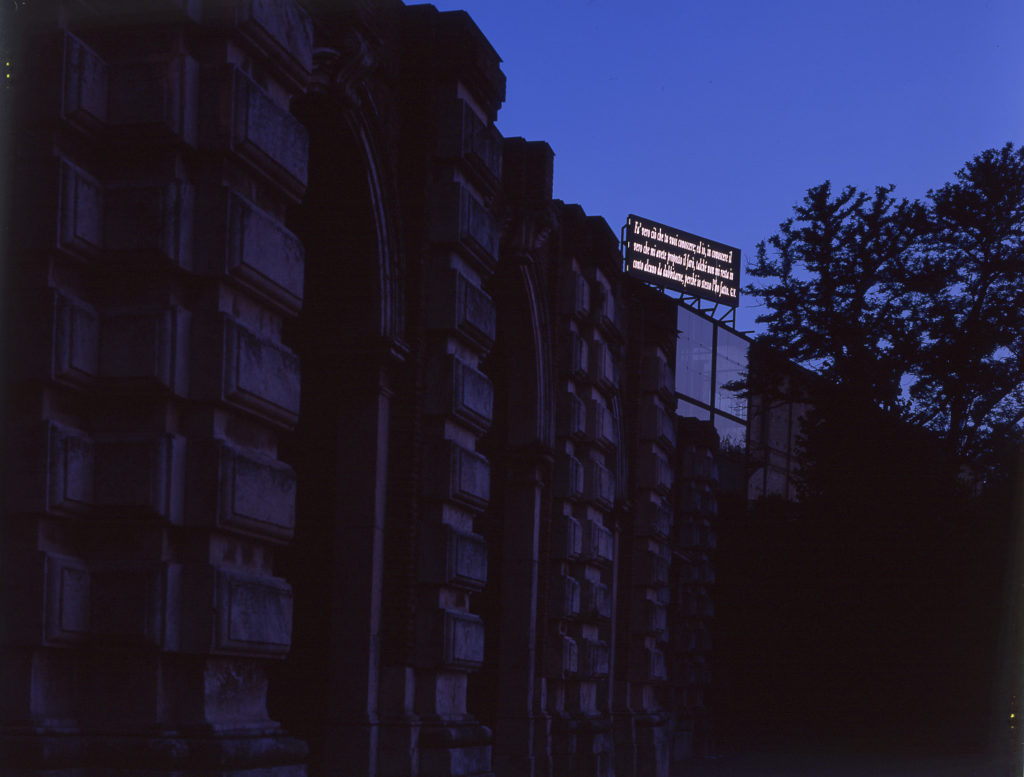Joseph Kosuth
Joseph Kosuth’s works investigate the fundamental principles of artistic expression, even calling into question the very concept of the work of art.Starting from the idea that a work of art is a tautology, since it is a representation of the artist ’s intention, Kosuth debates the nature of art, focusing on the ideational dimension of the work rather than limit art to its production and showing interest more in the true significance of the work of art than in its formal aspect. Through a radical operation, the artist strips down the art object, to arrive at a complete correspondence between the work and its meaning. Since, according to Kosuth, art should also be functional from a linguistic standpoint, the use of the word and its expressive code bring art back to its essential values, even turning it into a language.
In ‘Seeing Reading ’[cobalt blue ], 1979 (not reproduced),a series of words created in cobalt blue neon construct the following phrase: “This object, sentence, and work completes itself while what is read constructs what is seen ”.
Conceptually close to neon works from the 1960s, where, reasserting the concept of tautology, there was total identity between the work ’s significance and the represented phrase, Kosuth’s art is different since, in this case, complete identification does not occur, but instead the meaning of the work is given by the complementary and necessary presence of the action of seeing and reading, which find their meaning upon conclusion of the reading of the phrase.
The work ‘No Number #8 (+216 After Augustine’s Confessions)’, 1989, which is similar conceptually, is part of a series of works in which Kosuth refers to the Viennese philosopher Ludwig Wittgenstein. In this case the complete identification between meaning and the represented object is achieved by means of three sheets of glass of different dimensions, which, superimposed one upon another, contain, silkscreened in English, the same phrase by Wittgenstein, inspired by the Confessions of St.Augustine: “It is copied differently —but the copy is the same. But I want to say:if something else is seen, the copy must be different.”
‘Seeing Knowing’, 2004, in contrast, is a more recent work, created by Kosuth specifically for the spaces of the Museum.Conceived in two parts, theoretically in dialogue with each other, the work consists of two back-lit panels, one installed outside on the roof of the Manica Lunga building, the other positioned inside, on the third floor of the Castello. On both panels, one can read —in Italian on the outdoor panel, in English on the other —the following phrase, taken from the writings of the philosopher Giovanbattista Vico (1668-1744):“Fa ’ vero ciò che tu vuoi conoscere —;ed io,in conoscere il vero che mi avete proposto il farò,talché non mi resta in conto alcuno da dubitarne,perché io stesso l’ho fatto” (“Make true what you want to know-; and I in knowing the truth that you have proposed to me, will do it, so that I am not left with any reason to doubt it, since I myself have done it”).
A system usually used for advertising or promotional communications thus becomes a means for the dissemination of a philosophical statement that makes knowledge and the importance of the act of knowing the raw material for the comprehension of the true nature of existence.
[C.O.B.]


![‘Seeing Reading’ [cobalt blue]](https://www.castellodirivoli.org/wp-content/uploads/2012/03/Kosuth_seeing-reading.jpg)